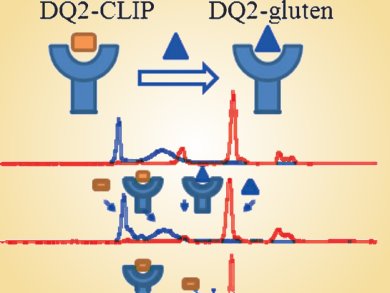In patients with celiac disease or gluten intolerance, human leukocyte antigen DQ2 (HLA-DQ2) protein binds peptides derived from partial hydrolysis of dietary gluten. This in turn activates inflammatory CD4+ T helper cells in the patients’ small intestine. The HLA-DQ2 protein–gluten peptide interaction is thus key to understanding celiac disease. A team of researchers led by Jiang Xia, Chinese University of Hong Kong, and Chaitan Khosla, Standford University, USA, report a way to simultaneously investigate the interactions of HLA-DQ2 with a variety of peptides in a single solution.
First, the peptides were labeled with a set of fluorescent probes that emit at different wavelengths. Then, capillary electrophoresis was used to separate the different protein–peptide complexes. Finally, the complexes were detected and identified by their fluorescence after excitation with a common light source.
Detection of individual binding events allowed measurement of association and dissociation kinetics, granting insight into the method of action of proteins and peptides involved in celiac disease. This method should also be applicable to other complex mixtures of proteins and peptides.
Image: © Wiley-VCH
- Resolving Multiple Protein–Peptide Binding Events: Implication for HLA-DQ2 Mediated Antigen Presentation in Celiac Disease,
J. Wang, X. Jin, J. Liu, C. Khosla, J. Xia,
Chem. Asian J. 2012.
DOI: 10.1002/asia.201101041



